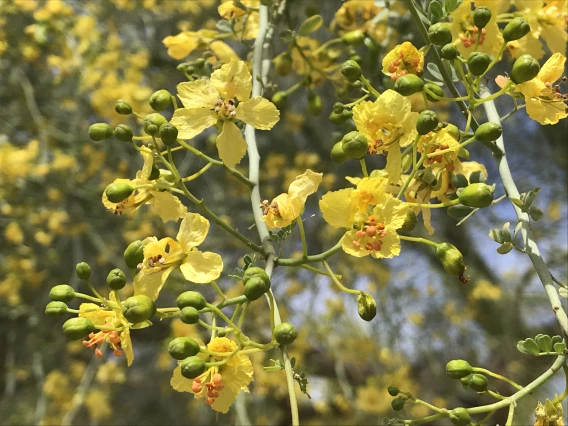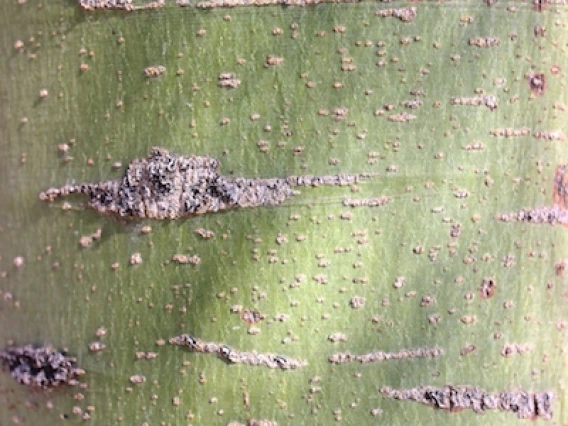


Common Names:
- English: Blue Palo Verde
- Spanish: Palo Verde
- O’odham: Ko’ Okma Ki
Botanical Name: Parkinsonia florida
Family Name: Fabaceae (pea/legume family) | Synonym: Leguminosae
Rain Garden Zone: P. florida thrives in the terrace rain garden zone, but can grow well in the bottom rain garden zone, provided that the base of the trunk is not subjected to prolonged periods (>12 hours) of standing water. The terrace zone is typically atop a terrace or on the bank of a basin or swale. These sites have more shallow, less-frequent, and more temporary pooling than in bottom zone.

Reproduced with permission from "Rainwater Harvesting for Drylands and Beyond" by Brad Lancaster, HarvestingRainwater.com
Flowering Season: Late March—early April
Harvest Season:
- Green Seed - Late April—May
- Dry Ripe Seed - June—early July
Harvest Techniques: Harvest pods carefully from this palo verde, as there are spines within the branches.
Planting Season: Monsoon
Landscape Cultivation: Nick the side of the seed coat—just enough to break the outer shell. In rain gardens, plant in the terrace zone. Be aware that blue palo verde trees are highly susceptible to parasitic mistletoe growth and palo verde beetle infestation.
Ecological Benefits: Palo verde trees are the primary nurse plants for the saguaro--that is, it provides a favorable microclimate for the saguaro to thrive. The palo verde provides shade for vulnerable saguaro seedlings and the leaf litter provides a nitrogen-rich root zone environment. This, coupled with mycorrhizal fungi (that allow the plant to fix nitrogen) provide adequate nutrition for the plant. The bright yellow blooms of the blue palo verde blooms attract bees and other pollinators while the canopy provides shade and shelter for mammals and birds.
Characteristics: Blue palo verde trees can grow to a height of 30 ft. The common name is inspired by the tree’s blue-green bark, which is able to carry out photosynthesis even when the tree drops its leaves in the hot summer months to reduce water loss. P. florida has bright yellow flowers and long, flat seed pods that produce seeds resembling lima beans. Spines grow on the branches of blue palo verde trees.
Practical Uses:
- Food - Both the flowers and the bean pods of the blue palo verde are edible. Green seeds can be blanched in pods and eaten immediately, frozen for later, or dried and ground into a flour. Mature, dry seeds can be ground into a flour as well as soaked and sprouted for use in recipes.
- Domestic Animals - Palo verde beans can be dried and used for cattle feed. Honey bees drink nectar, pollinate, and produce honey.
- Other Uses - blue palo verde has traditionally been used as a key source of food, and it is useful for shelter and wood/timber as well.
References:
- Desert Harvesters. (2018). Eat mesquite and more: a cookbook for Sonoran desert foods and living. Tucson, AZ. RainSource Press.
- Hodgson, W. C. (2001). Food plants of the Sonoran desert. Tucson, AZ. University of Arizona Press.
- Lancaster, B. (2019) Rainwater harvesting for drylands and beyond, 3rd edition. Tucson, AZ. RainSource Press.
- Little, E. L. (1980). The Audubon Society field guide to North American trees, western region. Alfred A. Knopf.
For more information on this plant, see the Campus Arboretum species description pages.
Go to the next tour stop: fishook barrel page or Return to the main Dunbar Spring tour page

